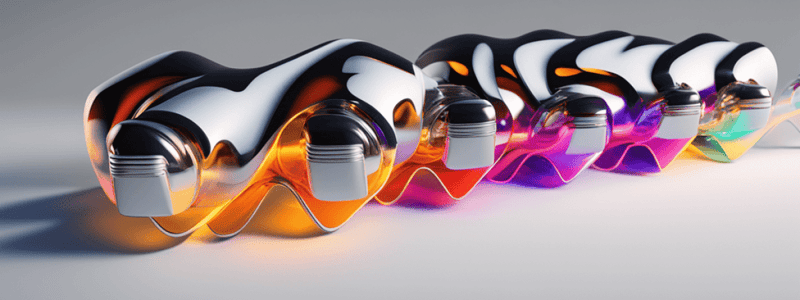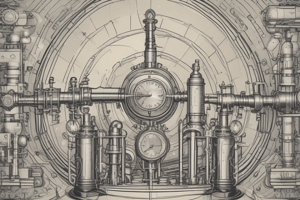Podcast
Questions and Answers
ما هو الوحدة الأكثر استخدامًا لقياس الضغط في الولايات المتحدة؟
ما هو الوحدة الأكثر استخدامًا لقياس الضغط في الولايات المتحدة؟
- البار (bar)
- الباسكال (Pa)
- الأتمسفير (atm)
- الباوند لكل بوصة مربعة (psi) (correct)
ما نوع الجهاز المستخدم لقياس الضغط الجوي؟
ما نوع الجهاز المستخدم لقياس الضغط الجوي؟
- المنيوميتر (Manometer)
- الباروميتر (Barometer) (correct)
- مقياس الهيدروليكي (Hydraulic gauge)
- البازيوميتر (Piezometer)
ما هي الوحدة التي تعادل تقريبًا 101,325 باسكال؟
ما هي الوحدة التي تعادل تقريبًا 101,325 باسكال؟
- البار (bar)
- الأتمسفير (atm) (correct)
- الباوند لكل بوصة مربعة (psi)
- الكيلوباسكال (kPa)
أي نوع من أنواع الأجهزة يُستخدم لقياس الضغط في سائل في فضاء محصور؟
أي نوع من أنواع الأجهزة يُستخدم لقياس الضغط في سائل في فضاء محصور؟
من يؤدي دورًا في الحفاظ على الغلاف الجوي للأرض في حالته الغازية؟
من يؤدي دورًا في الحفاظ على الغلاف الجوي للأرض في حالته الغازية؟
ما هو تأثير ارتفاع الضغط على المعادن؟
ما هو تأثير ارتفاع الضغط على المعادن؟
ما هي الظروف التي قد تؤدي إلى تساؤل الغازات بشكل يجعلها تتصرف على نحوٍ يشبه السوائل أو الصلب؟
ما هي الظروف التي قد تؤدي إلى تساؤل الغازات بشكل يجعلها تتصرف على نحوٍ يشبه السوائل أو الصلب؟
ما هو عامل يزيد من الضغط في السوائل؟
ما هو عامل يزيد من الضغط في السوائل؟
ما هي إحدى الظواهر التي يساهم في فهمها فهم الضغط السائد في السوائل؟
ما هي إحدى الظواهر التي يساهم في فهمها فهم الضغط السائد في السوائل؟
في أي مجال من المجالات التالية قد تكون فهم تأثيرات الضغط على المواد أمرًا حيويًا؟
في أي مجال من المجالات التالية قد تكون فهم تأثيرات الضغط على المواد أمرًا حيويًا؟
ما هو العامل الرئيسي الذي يتسبب في الضغط الجوي؟
ما هو العامل الرئيسي الذي يتسبب في الضغط الجوي؟
ما هي وحدة قياس الضغط الأكثر شيوعًا للقوى الصغيرة مثل تلك المؤثرة على الأسطح داخل فتحات صغيرة؟
ما هي وحدة قياس الضغط الأكثر شيوعًا للقوى الصغيرة مثل تلك المؤثرة على الأسطح داخل فتحات صغيرة؟
ما المادة التي يتزايد ضغطها كلما زاد عمقها؟
ما المادة التي يتزايد ضغطها كلما زاد عمقها؟
أي من هذه الأجهزة تُستخدم لقياس الضغط في سائل في مساحات محصورة كصنابير المياه؟
أي من هذه الأجهزة تُستخدم لقياس الضغط في سائل في مساحات محصورة كصنابير المياه؟
ما هي تأثيرات ارتفاع الضغط على المعادن؟
ما هي تأثيرات ارتفاع الضغط على المعادن؟
ما هي الوحدة المستخدمة لقياس الضغط في وحدات الضغط الدولية الرئيسية؟
ما هي الوحدة المستخدمة لقياس الضغط في وحدات الضغط الدولية الرئيسية؟
ما هي وظيفة جهاز الهيدروليك بارامتر الضغط؟
ما هي وظيفة جهاز الهيدروليك بارامتر الضغط؟
ما هو التأثير الذي يمكن أن يحدثه التغير في الضغط على المواد؟
ما هو التأثير الذي يمكن أن يحدثه التغير في الضغط على المواد؟
ما هو الجهاز المستخدم لقياس فروقات الضغط بين نقطتين؟
ما هو الجهاز المستخدم لقياس فروقات الضغط بين نقطتين؟
ما هو المفعول الذي يمكن لبعض المواد تحمله من قوى مضغية والعودة إلى شكلها الأصلي بعد التشوه؟
ما هو المفعول الذي يمكن لبعض المواد تحمله من قوى مضغية والعودة إلى شكلها الأصلي بعد التشوه؟
Flashcards are hidden until you start studying
Study Notes
Pressure: A Force Shaping Our World
Pressure, a fundamental concept in physics and chemistry, is a measure of force applied per unit area. It influences our everyday lives, from the air we breathe to the water we drink. Let's explore how pressure manifests in various contexts.
Atmospheric Pressure
The Earth's atmosphere exerts pressure on everything around us, averaging about 101,325 pascals (Pa) at sea level. This pressure is responsible for keeping our atmosphere in its gaseous state and holding the weight of the atmosphere above us.
Pressure Units
Pressure is commonly measured in pascals (Pa), but there are other units too:
- Atmosphere (atm): A historical unit, equal to approximately 101,325 Pascals.
- Bar (bar): A commonly used unit, with 1 bar = 100,000 Pa.
- Pound per square inch (psi): A unit used in the United States, with 1 psi = 6,894.76 Pa.
Knowing how to convert between these units is helpful for understanding pressure measurements in different contexts.
Pressure Measurement Devices
A variety of devices can measure pressure, including:
- Barometer: A device used to measure atmospheric pressure.
- Hydraulic gauge: A device that measures fluid pressure through the displacement of a fluid.
- Piezometer: A device used to measure pressure in a liquid in a confined space.
- Manometer: A device used to measure the pressure of gases and liquids by comparing their relative heights and densities.
These devices use different principles to measure pressure, and their choice depends on the specific application.
Fluid Pressure
Fluid pressure, also known as hydrostatic pressure, is the force applied by a fluid per unit area. It increases with depth in a fluid. This pressure is essential in understanding various phenomena, such as:
- Fluid statics: The management of fluids at rest.
- Hydraulics: The study of fluids in motion.
- Hydrodynamics: The study of fluids in motion with regard to their dynamic behavior.
Effects of Pressure on Different Materials
Pressure influences materials in various ways:
- Metals: High pressure can cause metals to become harder and more brittle, or softer and more ductile, depending on the specific material.
- Crystals: High pressure can alter the crystal structure of some materials, leading to the development of new materials and properties.
- Liquids: High pressure can lead to the liquefaction of gases, the dissolution of solids in liquids, and the formation of new liquid phases.
- Gases: High pressure can lead to the compression of gases, causing them to behave more like liquids or solids at extreme conditions.
Understanding pressure's effects on materials is crucial in various industries, including materials science, geophysics, and chemical engineering.
Pressure is a fundamental concept with widespread applications in our everyday lives and scientific endeavors. By exploring the various facets of pressure, we gain a deeper understanding of the physical world around us.
Studying That Suits You
Use AI to generate personalized quizzes and flashcards to suit your learning preferences.




